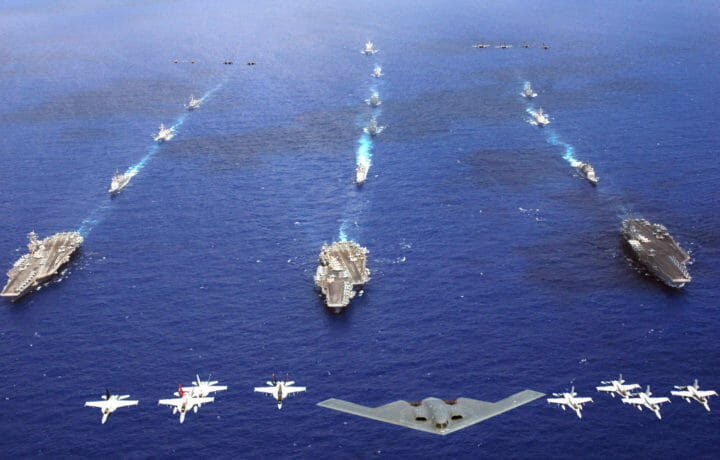Today it is possible to walk the decks of five retired United States Navy aircraft carriers that have been preserved as museum ships. How those vessels will survive the ravages of time is an ongoing concern, but it is important to note that there will never likely be another flattop museum added to the list even as the Navy has retired multiple carriers in the past two decades.
In fact, getting rid of its future retired aircraft carriers could be a huge headache – because all of the currently in-service vessels are nuclear-powered.
The End of the Conventional Carriers
Last year, the retired carriers USS Kitty Hawk (CV-63) and USS John F. Kennedy (CV-67) were sold to International Shipbreaking Limited in Texas for just one cent each. The two final conventionally powered carriers were launched in the 1960s and retired in 2009 and 2007 respectively. There had been efforts to see the carriers maintained as floating museums, but the donation status was subsequently revoked – and instead, the vessels will be broken apart in a process that could around 18 months each.
It is notable that USS Kitty Hawk was laid down in December 1956, launched in May 1960, and then commissioned in April 1961. Thus the time to take it apart will be significantly shorter than it took to build the carrier. In fact, throughout history, breaking up warships has proven a lot easier to conduct than building them.
Of course, in some cases, old warships have been used as floating targets and sunk in everything from gunnery practice to nuclear tests.
Moreover, the last U.S. Navy carrier actually sunk was the USS America (CV-66), which was scuttled in May 2005 after being used as a target off Cape Hatteras. Due to environmental concerns, the U.S. likely won’t employ such a tactic in the future. However, this past February, the Brazilian Navy opted to scuttle and sink its flagship carrier São Paulo after it was denied scrapping in Turkey due to concerns about the amount of asbestos onboard the French-made vessel, which was originally launched as the Foch.
The USS Enterprise is Next
In 2012, the former USS Enterprise (CVN-65), the world’s first nuclear-powered aircraft carrier was retired after more than five decades in service. At the time of her inactivation, she was the third-oldest commissioned vessel in the U.S. Navy after the wooden-hulled USS Constitution and the USS Pueblo – the latter of which was captured by North Korea in January 1968.
CVN-65 was officially decommissioned in February 2017.
Naval enthusiasts called for the ship to be converted into a museum, but it was deemed too expensive – due in part to the fact that the ship would need to be partially dismantled to remove her eight nuclear reactors. That process proved to be complicated, and the recycling of Enterprise was even delayed by the navy until a more environmentally responsible process could be developed.
While the Navy sold the two conventionally-powered carriers for a penny each, it will have to pay for the Enterprise‘s recycling. And it won’t either cheap or quick process.
As of last year, it was estimated that dismantling the carrier could take at least five years and cost between $554 and $696 million at a commercial yard. Another plan called for the dismantling to take upwards of 15 years and cost as much as $1.358 billion. One issue is that U.S. Navy shipyards are overworked, and can’t adequately address the maintenance for active warships – and there simply isn’t the capacity to take old nuclear-powered carriers apart.
Planning Ahead
Few likely considered the end of service for the USS Enterprise when she was designed and built in the 1950s, but that was also a time when nuclear tourism in Las Vegas was actually a thing. Nuclear power clearly offered benefits, notably unlimited endurance – provided food and water could be supplied to the crews.
Last month, the U.S. Navy published a pre-solicitation notice announcing that Huntington Ingalls’ Newport News Shipbuilding division would formulate requirements for scrapping the next nuclear-powered carrier, USS Nimitz (CVN-68).
Commissioned in 1975 as the lead vessel of a class of 10 carriers, CVN-68 is expected to be retired in 2025. She will be followed by USS Dwight D. Eisenhower (CVN-69), which could be retired as early as 2029. The Navy will replace the Nimitz-class on a one-for-one basis with the Gerald R. Ford-class of carriers over the next three decades.
Retiring and recycling nuclear-powered carriers could prove more expensive than anticipated.
“The bulk of the Navy’s past dismantlement and disposal work is comprised of comparatively low-cost projects—particularly submarines—with limited resource demands compared to a nuclear-powered aircraft carrier like CVN 65 [USS Enterprise], a multi-year project with a cost that will potentially exceed $1 billion,” noted a 2018 Government Accountability Office report. The report estimated that a nuclear-powered submarine costs around $26 million to scrap.
The Navy has already successfully dismantled a number of submarines, as well as its nine nuclear-powered cruisers. The size of the carriers is an issue. These are big ships, and recycling them is proving to be a big headache that isn’t going to go away soon.




